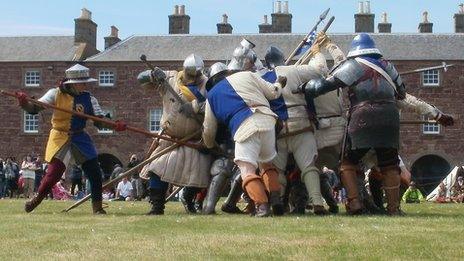Scottish battlefields: Inventory recognises 39 historic sites
- Published

The Battle of Culloden, near Inverness, in 1746 is one of the 39 in the inventory
Thirty-nine sites of violent clashes on Scottish soil have been officially recognised in Scotland's Inventory of Historic Battlefields.
The database has been put together by Historic Scotland to give greater protection to the sites and to act as a guide to planning authorities.
It includes famous battles such as Bannockburn, Culloden and Killiecrankie.
Less well known Alford and Skirmish Hill also feature.
Work started on the inventory about four years ago with the public consulted on battlefields suggested for inclusion.
The 39 scenes of conflicts - selected from a list of 50 - were added to the database in three phases of consultation and research.
The most recent phase placed 11 sites in the inventory and included:
Dunbar I (1296) in East Lothian, which marked the first battle of the Scottish Wars of Independence
Dunkeld (1689) in Perth and Kinross saw house-to-house fighting between Jacobite and government forces
Glenlivet (1595) in Moray pitted forces loyal to the 1st Marquis of Huntly and 9th Earl of Erroll against those of the 7th Earl of Argyll
Loudon Hill (1307) in East Ayrshire marked one of Robert the Bruce's first victories over English troops
Skirmish Hill (1526) was an effort by Walter Scott of Buccleugh and 600 Borderers on horseback to free the young King James V from the custody and influence of the Archibald Douglas, the Earl of Angus.
Historic Scotland said more battlefields could be added at later dates.
Culture and External Affairs Secretary Fiona Hyslop said it was a real achievement that so many battles had been researched.
She said: "The interest in protecting battlefield sites from across the country has been immense and continues.
"The consultation in 2008 generated more responses from the public than any other Historic Scotland policy at that time."
Ms Hyslop added: "Introducing this first Inventory of Historic Battlefields acknowledged this high level of public interest and support for giving lasting recognition to places where lives have been lost, even where no other commemoration has existed."

The inventory lists battles from the 13th to the 18th centuries
The full list of battlefields, external added in three phases held so far are: Alford (1645), Ancrum Moor (1545), Auldearn (1645), Bannockburn (1314), Bothwell Bridge (1679), Culloden (1746), Dunbar II (1650), Dupplin Moor (1332), Falkirk II (1746), Glenshiel (1719), Harlaw (1411), Killiecrankie (1689), Kilsyth (1645), Philiphaugh (1645), Pinkie (1547), Prestonpans (1745) and Sheriffmuir (1715).
Barra (1308), Carbisdale (1650), Cromdale (1690), Drumclog (1679), Fyvie (1645), Inverkeithing II (1651), Inverlochy II (1645), Linlithgow Bridge (1526), Mulroy (1688), Rullion Green (1666) and Stirling Bridge (1297).
Blar-na-Leine (1544), Dunbar I (1296), Dunkeld (1689), Glenlivet (1594), Inverlochy I (1431), Langside (1568), Loudoun Hill (1307), Roslin (1303), Sauchieburn (1488), Skirmish Hill (1526) and Tippermuir (1644).
Dr Iain Banks and Dr Tony Pollard at Glasgow University's Centre for Battlefield Archaeology carried out the research.
Dr Banks said: "These sites preserve the last traces of historical events that shaped the nation of Scotland through history, and there is no substitute for visiting the battlefields for understanding what happened in each battle."
He added: "What we have found when researching the battlefields is that there is never any difficulty in persuading people of the importance of a particular site.
"The most difficult job has been explaining why individual battlefields have not made it onto the inventory.
"We have been really astonished at the high levels of enthusiasm for the preservation of battlefields at the local level - people are fascinated by them and want to see them preserved."
- Published16 December 2012
- Published26 August 2011
- Published8 August 2011
- Published13 December 2010